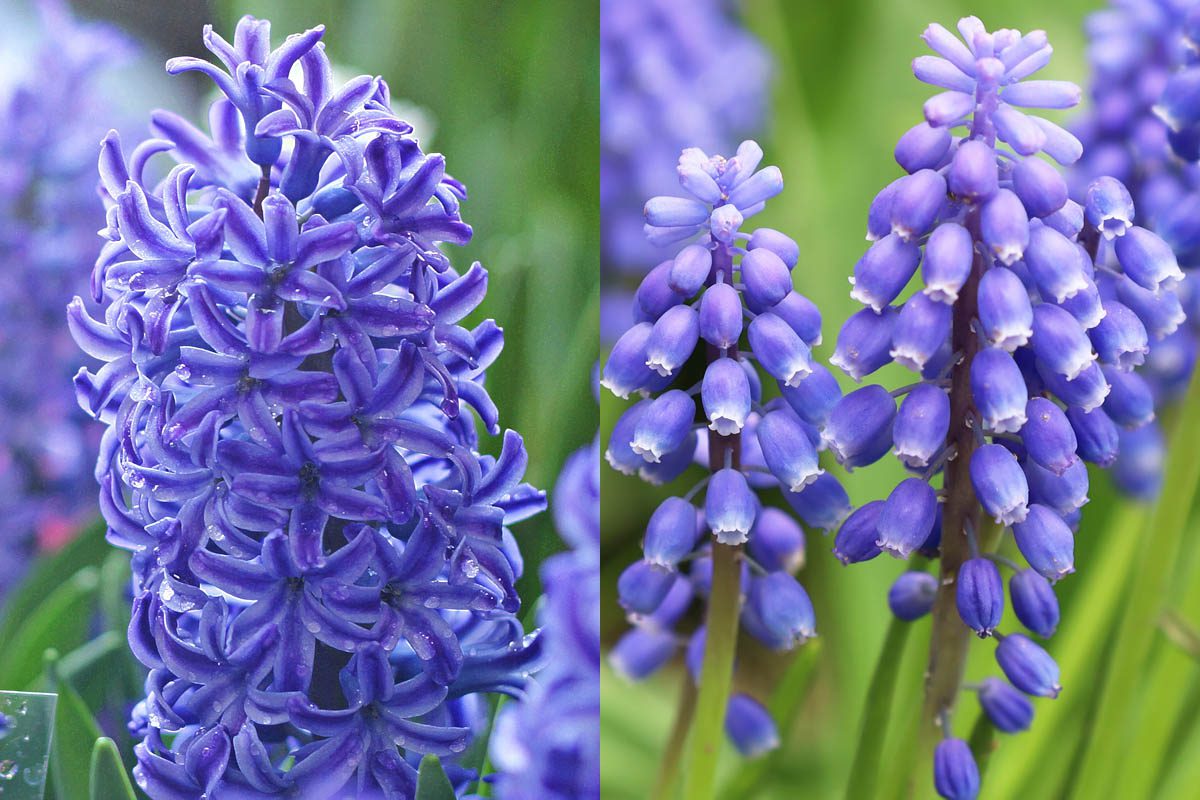Hyacinth and grape hyacinth are two distinct species of flowering bulbs that belong to the Asparagaceae family. Hyacinths (Hyacinthus) and grape hyacinths (Muscari) are related, but they belong to different genera within the family Asparagaceae. Despite their similar names and appearance, they are distinct species.
Hyacinth

Hyacinth (Hyacinthus spp.) is a genus of approximately 70-75 species of highly fragrant spring flowering bulbs that are native to the eastern Mediterranean region.
The scientific name Hyacinthus is derived from Greek mythology. Hyacinthus was a beautiful Spartan youth and the lover of Apollo. Zephyrus, the God of the West wind was also in love with Hyacinthus and jealous of Apollo’s love of him. One day, while Apollo and Hyacinthus were throwing a discus. Zephyrus redirected the discus to which struck Hyacinthus in the head, mortally wounding him. Apollo, filled with grief over the loss of his beloved friend, could not allow Hades to take Hyacinthus to the Underworld. Instead, Apollo transformed his fallen friend into a flower named after him.

Hyacinths produce dense spikes of bell-shaped blossoms (botanically known as racemes), in spring which grow in blue, purple, pink, white, and yellow. The inflorescence of hydrangea is generally a corymb, which is a type of flower cluster where the outer flowers have longer stems, allowing the entire cluster to have a more or less flat top. The highly scented flowers make hyacinth a popular choice for gardens and indoor pots. Beyond its aesthetic appeal, the hyacinth’s bulbs and leaves are used in some traditional medicines, though it’s crucial to handle them with care as they can be potentially toxic.
Grape hyacinth

Grape hyacinths are a genus of approximately 50 species that are native to the Old World, ranging from Europe and the Mediterranean region to western and central Asia (Muscari spp.), These spring-blooming bulbous plants belong to the Asparagaceae family. Its common name is derived from the resemblance of its small, urn-shaped flowers (botanically known as urceolate) to clusters of grapes. The tightly packed blooms are typically blue to purple, though some varieties display white or pale pink hues. The leaves of grape hyacinth are narrow and grass-like, providing a delicate backdrop to the vibrant blooms.
Grape hyacinth is an easy-to-grow plant, that naturalises easily to form a beautiful carpet of colour. It pairs well with daffodils and tulips and is often grown in what is termed a ‘bulb lasagna’, which is a gardening technique where different types of flower bulbs are planted in layers within the same container or garden bed, much like the layers in lasagna. This method is used to create a succession of blooms from early spring to late spring or even early summer, as the different types of bulbs bloom at different times.
The name muscari is in reference to the musk-like scent of the flowers.
Difference between hyacinth and grape hyacinth
| Hyacinth | Grape Hyacinth | |
|---|---|---|
| Scientific Name | Hyacinthus orientalis | Muscari |
| Common name | Hyacinth | Grape hyacinth, muscari |
| Family | Asparagaceae | Asparagaceae |
| Origin | Eastern Mediterranean | Eurasia |
| Flower shape | Bell or star-shaped, clustered closely along the stem | Small, urn-shaped flowers tightly packed along the stem resembling clusters of grapes |
| Flower size | Larger, individual flowers can be an inch or more across | Smaller, individual flowers are usually less than 1 cm across |
| Flower colour | Blue, pink, yellow and white | Blue or white |
| Flower arrangement | Flowers are more loosely arranged in a single spike | Flowers are tightly packed in elongated clusters |
| Fragrance | Usually heavily fragrant | Mild musk fragrance |
| Leaf shape | Broad, strap-like leaves | Narrow, slender leaves |
| Height | 15-20 cm | 8-10 cm |
| Bloom time | Early to mid-spring | Mid to late spring |
| Bulb size | 10 – 15 cm diameter | 3-4 cm diameter |
| Pests and diseases | Aphids, slugs | Fewer pest problems |
| Maintenance | Generally need more care, especially in terms of watering and preventing rot | Tend to require less maintenance and can naturalise easily in gardens |
| Uses | Often used in formal bed plantings, containers, and as cut flowers | Commonly used in rock gardens, borders, and naturalised areas |
| Toxicity | Toxic | Mildly toxic |
| Toxic properties | Insoluble calcium oxalate and lycorine | Insoluble calcium oxalate and alkaloids |
Julia is a writer and landscape consultant from Wollongong with a love of horticulture. She had been an avid gardener for over 30 years, collects rare variegated plants and is a home orchardist. Julia is passionate about learning and sharing her knowledge of plant propagation and plant toxicology. Whether it’s giving advice on landscape projects or sharing tips on growing, Julia enjoys helping people make their gardens flourish.




